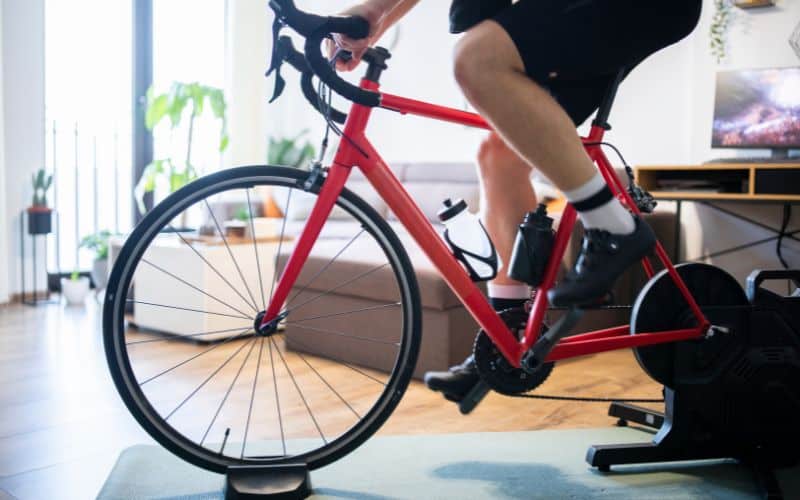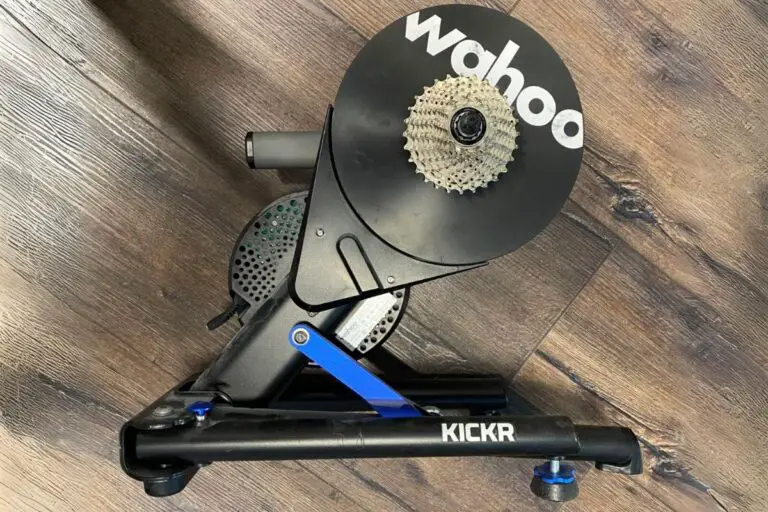Silence your bike trainer with everyday items.
Most people think reducing bike trainer noise requires technical expertise or special equipment. However, everyday household items can be surprisingly effective in dampening the noise. This method transforms your noisy trainer into a whisper-quiet exercise machine.
Experience a quieter ride with items you already own.
Understanding Bike Trainer Noise Sources
To successfully reduce noise from your bike trainer, you need to pinpoint where it’s coming from.
Types of Bike Trainers
Your choice of bike trainer significantly impacts the noise level during your workouts. Bike trainers come in several types, each with unique noise characteristics.
- Wheel-on trainers are popular for their convenience but can create noise through the friction between the bike’s rear wheel and the trainer’s cylinder.
- Direct drive trainers, where you remove the rear wheel and connect the bike directly to the trainer, are generally quieter but might still produce some noise depending on the resistance mechanism.
- Fluid trainers offer progressive resistance and are known to be quieter, with the resistance unit containing fluid that can help to dampen noise. However, they might still emit some noise due to moving internal parts.
- On the other hand, magnetic trainers use a magnetic field for resistance and can be pretty loud, particularly at higher resistance levels or speeds.
Common Noise Culprits
The primary sources of noise and vibrations in bike trainers include:
- Tire type and pressure: Standard tires can be noisy on a trainer. Using trainer-specific tires can make a significant noise difference.
- Flooring: The surface where the trainer is set up can amplify noise. Rubber mats can help reduce this.
It’s helpful to keep your trainer well-maintained and ensure parts are adequately tightened to minimize noise. Regular cleaning and lubrication can also reduce noise from the drive train.
Soundproofing Basics
Reducing noise isn’t just about the equipment; it’s also about optimizing your cycling training space. Implement these soundproofing strategies to minimize sound transmission and vibration:
- Use a Mat: Place a dense rubber mat under your trainer to absorb vibrations.
- Isolation Pads: Small, dense foam pads can be placed under the trainer’s feet to dampen noise.
- Walls and Floors: Soft materials on walls, like foam panels or heavy curtains, can help reduce echo, while carpets can dampen floor vibrations.
You’ll see a notable noise reduction by selecting a quiet bike trainer and employing basic soundproofing techniques.

Optimizing Bike Setup
For a quieter indoor cycling experience, pay attention to your bike setup. Careful selection and maintenance of specific components can lead to a more silent operation of your indoor trainer.
Trainer-Specific Tires
For wheel-on bike trainers, trainer-specific tires are your first go-to solution for noise reduction. These tires are designed to grip the trainer’s drum effectively, reducing slippage and thus cutting down on noise. The key advantages are:
- Reduced noise: Tailored for the trainer’s surface to lessen vibrations.
- Durability: Generally last longer than regular road tires when used on a trainer.
Using standard tires on a trainer can make more noise, as their tread isn’t designed for the smooth surface of a trainer drum. Switching to trainer-specific tires can lower noise and decrease wear on your regular tires.
Drivetrain Maintenance
A well-maintained drivetrain operates more quietly.
- Check your bike chain: Regularly inspect for signs of wear or damage.
- Clean and lubricate: Use a quality chain lube to ensure smooth movement and reduce noise.
- Regular check-ups: Frequently check the entire drivetrain for any debris or damage.
Maintaining a clean and well-lubricated drivetrain reduces resistance and noise. To achieve this, clean the drivetrain thoroughly to eliminate grime that can create noise, and then apply lubricant sparingly to prevent attracting additional dirt.
Surrounding Acoustic Enhancements
The type of floor your bike trainer is set up on significantly affects noise levels. The right mat or flooring solution can help dampen sound and reduce vibration.
The Role of Trainer Mats
Trainer mats are specifically designed to go beneath your bike trainer. They serve multiple purposes:
- Noise reduction: They absorb vibrations, which in turn reduces noise transmission.
- Protection: They shield your floor from sweat and mechanical wear.
When choosing a trainer mat, consider:
- Material: Dense, heavy-duty rubber or PVC mats are most effective.
- Size: Ensure the mat is large enough to accommodate your bike and trainer without overhang.
Consider a rubber mat if you need a quick solution, but a thicker PVC mat might offer better noise insulation for more permanent setups.
Effective Flooring Solutions
The key to minimizing vibration transfer is to create a barrier between your bike trainer and the floor. Here are some options:
| Material | Use Case | Benefits |
|---|---|---|
| Carpet | Temporary and easy to set up. Best paired with a trainer mat for added protection. | Accessible; reduces some noise. |
| Rubber Mat | Daily training; heavy use. | Durable; offers good noise and vibration control. |
| Interlocking Rubber Tiles | Custom-fit spaces; multi-purpose rooms. | Flexible design; effective noise control. |
| Corkboard | Less common eco-friendly solution, long-term use. | Natural insulation properties; absorption. |
Additionally, you can use isolation pads or anti-vibration mounts under trainer legs to further dampen vibrations.

Fans and Wind Resistance
When you ramp up your indoor cycling session, airborne noise can become quite noticeable, primarily from fans and wind resistance.
The fan within your bike trainer, especially those with fan-based flywheels, generates wind noise as you pedal. Noise levels can increase with the intensity of your workout. To reduce the decibels, consider:
- Upgrading to a quieter fan: Some fans are designed to be quieter while providing adequate airflow.
- Position of the fan: Place your fan at an angle or in a spot where it’s less likely to reverberate throughout the room.
- Use of natural ventilation: If possible, open a window for airflow to reduce your reliance on a fan.
Creating a Quiet Cycling Space
Your room’s attributes can affect how sound travels. Use soft furnishings like couches, curtains, and bookshelves filled with books to absorb sound waves and prevent them from bouncing off hard surfaces.
You can take it up a notch by installing acoustic panels on walls to catch and dissipate noise, significantly dropping ambient sounds.
Ensure doors and windows are sealed well to prevent sound leakage. If you are in an apartment, positioning your indoor cycling setup in a room that doesn’t share walls with neighbors can make a substantial difference in noise reduction.
Technological Solutions
Technology offers some advanced options when it comes to making your bike training sessions quieter. Smart trainers and dedicated cycling apps are at the forefront, mainly when used with the ERG mode functionality.
Smart Trainers and Apps
Investing in a smart trainer like the Wahoo KICKR or Saris H3 can significantly reduce noise. These trainers are designed to be quieter than traditional wheel-on trainers, using a direct drive system to eliminate the noise of a tire spinning on a roller.
- Silent Features:
- Wahoo KICKR: Near-silent operation thanks to its belt motor design.
- Saris H3: Claimed to be sound-tuned to reduce operational noise.
When paired with apps like Zwift, smart trainers can simulate outdoor riding in a quiet and controlled indoor environment.
Improving Experience with ERG Mode
ERG mode is a feature that automatically adjusts resistance on your smart trainer to help you maintain a specific power output during your training. This feature is particularly beneficial for keeping noise levels down because it results in steady resistance, equating to less noise variance.
- Consistent Pedaling:
- ERG mode encourages a consistent cadence, leading to smoother cycling and less noise.
- Gear Selection:
- Staying in a gear that promotes a quiet operation while using ERG mode ensures optimal noise control.
Apps like Zwift support ERG mode and can transform your noisy training session into a far quieter experience.
Maintaining Your Trainer
Proper maintenance of your bike trainer is essential not just for a quieter ride but also for prolonging the life of your equipment. This includes regular lubrication and timely upgrading or replacement of parts as needed.
Regular Lubrication
To decrease noise and wear, regularly lubricate the moving parts of your trainer. This includes the following:
- Chain: Use a bike-specific lube rather than household oils or WD-40.
- Rollers: For wheel-on trainers, ensure the rollers are clean and lubricated.
Here’s how:
- Clean the parts you plan to lubricate with a dry cloth to remove dirt or debris.
- Apply lubricant sparingly to avoid excess that could attract more dirt.
Note: Always refer to your trainer’s manual to understand the correct lube type and the recommended lubrication frequency.
Upgrade and Replacement
Occasionally, parts will wear out, and you may notice increased noise. Here’s what you should consider:
- Trainer-Specific Tires for Wheel-On Trainers: These are designed to reduce noise and often last longer.
- Direct-Drive Trainers: Investing in a new bike trainer, like a high-end direct-drive model, can reduce noise significantly compared to wheel-on models.
Frequently Asked Questions
What are effective methods to reduce bike trainer noise in an apartment?
Firstly, consider using a noise-reducing mat designed explicitly for bike trainers. These mats not only minimize vibration and sound but also protect your floor.
Additionally, selecting a trainer with a quieter mechanism, like a direct drive or fluid trainer, can significantly reduce noise levels. Regular maintenance of your bike and trainer, including tightening loose parts and ensuring proper alignment, can also reduce noise.
Which is quieter: magnetic or fluid bike trainers?
Generally, fluid bike trainers are quieter than magnetic trainers.
Fluid trainers use a thick liquid to create resistance, which typically generates less noise than the magnetic flywheel mechanism in magnetic trainers. Fluid trainers offer a smoother and more road-like feel, contributing to less noise.
However, the noise level can also depend on the specific model and brand of the trainer.
How does tire choice impact the noise level of a bike trainer?
Smooth, trainer-specific tires are designed to reduce noise and provide a quieter ride than regular road tires. These special tires have a dense, smooth rubber compound that minimizes vibration and noise.
Properly inflating your tires to the recommended pressure can reduce noise levels.
Are there any DIY solutions to make my bike trainer quieter?
One effective method is constructing a vibration-dampening platform using layers of foam and plywood. You can also try wrapping foam or rubber materials around parts of the trainer that make contact with the floor.
However, ensure that any DIY modifications do not compromise the stability and safety of the trainer.

